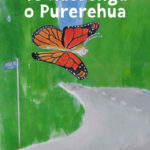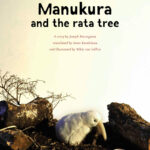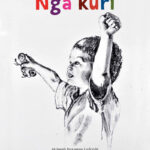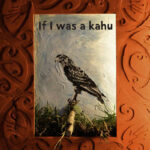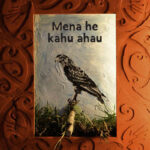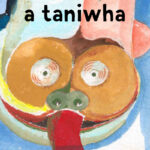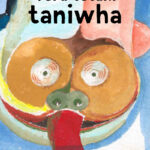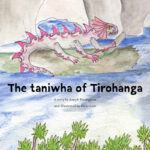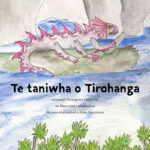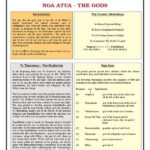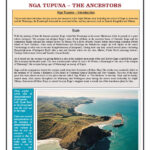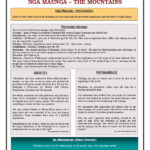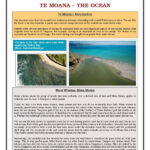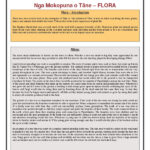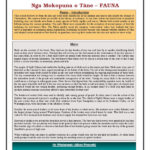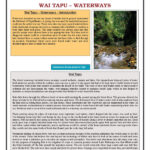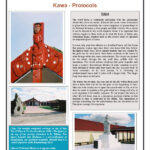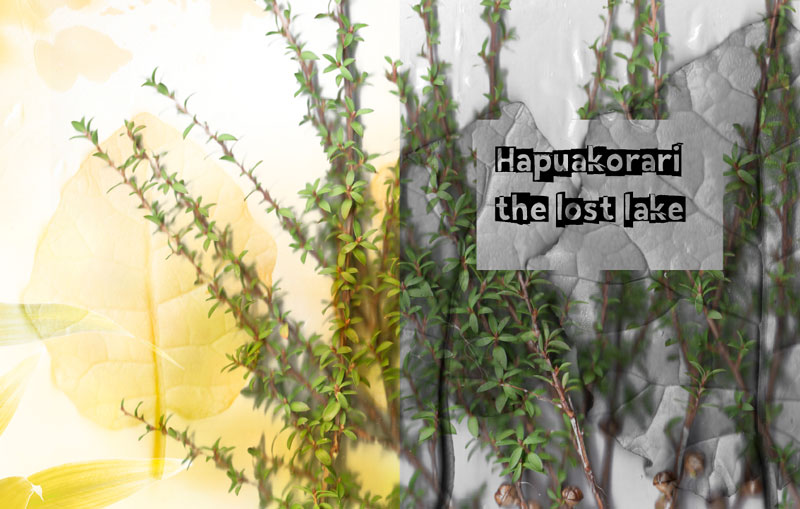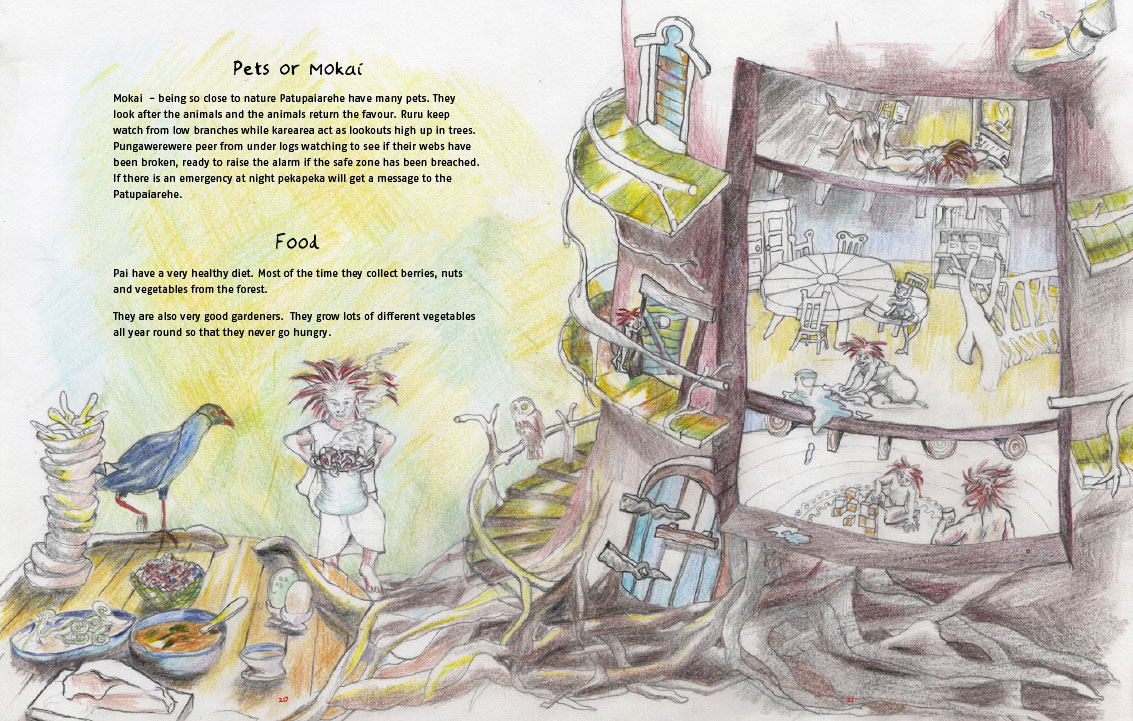Heading southwest from Pukaha (Mt Bruce) there is a place of significance in a small lake that Maori know as Hapuakorari. It has been located near the headwaters of the Ruamahanga River in the Tararua Mountains for time immemorial. Few people have probably even heard of it but for those that have it is hard not to become fascinated. This is in no small part due to the many stories that have been attributed to the lake and the name Hapuakorari. It is almost mythical, as you will see pieces of information that delve into the realms of stories such as King Solomon’s mines, within other stories we find a touch of Shangri la and overall the recent history is full of mystery.
Hapuakorari was said to have been a place of unparalleled beauty, a sacred place shrouded in mysticism. For a start a legendary bird, the Hokio, lived by the lake in the company of the Kotuku (white heron), Huia, Kereru and Kaka. Living between beautiful Beech and huge Rimu trees were a variety of rare plants, all surrounding a pebbled beach on the water edge. Within the crystal clear waters massive two headed eels swam.
History of Hapuakorari
During the 19th century one of the Wairarapa regions most enduring mysteries was to first locate, and then determine, the true identity of the lost lake of the Tararuas, known to tangata whenua as Hapuakorari. There was a certain mystery about the lake that drew European explorers to search for it. During the period of early European settlement the Rangitāne and Muaupoko tribes along with the Ngai Tahu, Ngāti Hāmua and Ngāti Moe hapū held fast to oral histories based around Hapuakorari. The meaning of Hapuakorari can be broken into two parts. Hapua, being a lake or lagoon and Korari, meaning flax sticks. Therefore Hapuakorari is literally ‘The Lake of the flax sticks’.
The name Hapuakorari came from huge flax bushes that grew around the lake that were said to tower up to 30 feet high and had stalks as thick as a mans leg. It is said that the prominent Wairarapa chief Tunuiarangi, Major Brown kept one of these stalks at his meeting house – Nukutaimemeha in Carterton. It was also said that a table in the house had legs made of the flax stalks. He kept these examples to show anyone who was sceptical of the flax’s existence. Several live pieces of the Hapuakorari flax were planted on the edge of the flowing stream at the site of Rathkeale College near Masterton.
On the eastern side of the Tararua Mountains, ancestors of the Ngāti Hāmua hapū talked about how when the sun shone directly onto Hapuakorari the reflection shimmered down into the central Wairarapa valley. For this reason the lake became known as the ‘pulse of the fish’. This relates to Te Ika a Maui or The fish of Maui (The North Island of New Zealand) where Palliser Bay is the mouth of the fish and Lake Wairarapa the eye.
Members of a prominent Ngāti Hāmua family of the Masterton area were said to each possess a gold nugget. The nuggets were said to have come from seams of gold found near the lake. Today the nuggets have disappeared. However some of our kaumātua today who are the children of the brothers who possessed the gold remember their fathers showing them the nuggets. From the stories handed to our kaumātua there was a suggestion that the lakebed had at one time been covered with both gold and diamonds and that this was the reason for the pulse of the fish.
The name ‘the lost lake of the Tararuas’ was given in part due to unsuccessful attempts of early European explorers to locate it but equally many Māori failed in bids to find it as well. One explanation as to why no one could find Hapuakorari is found in its status as a sacred place. There are certain points around the Wairarapa that transmit powerful energies that can be utilised by people versed in the appropriate ways to communicate with atua (the gods). Hapuakorari was one such place that was used as a retreat by Tohunga who would go to the lake in order to commune with the atua, gather plants for medicinal purposes and to draw upon the energies of the lake. As the lake was a place of extreme sacredness Tohunga would not disclose its location. If a person that did not hold the correct status neared the lake the atua would send down a heavy mist that would keep the lakes identity a secret.
A group of unidentified Wairarapa Māori was fleeing from the western side of the Tararua Mountains back into the Wairarapa. In hot pursuit of these people were parties of a Ngāti Toa, Ngāti Raukawa, and Te Ati Awa alliance who were looking to recapture and then slay the escapees. Upon nightfall the fleeing party took refuge on the island in the middle of Hapuakorari to avoid detection from their assailants.
A pa once stood near the lake following early European contact with New Zealand. We know this because those living at the pa had a special duty to perform that aided in communication between relations on either side of the mountains. The people of the pa were able to utilise the musket to warn others further down either side of the Tararua of impending trouble from approaching strangers. During a time of bereavement a musket served the same purpose in that shots alerted those on the west that someone on the east had passed away.
In 1873, the Government purchased the Tararua Block from two tribes (Rangitāne o Wairarapa and Muaupoko) and three hapū (Ngai Tahu, Ngāti Moe and Ngāti Hāmua). The 114,500-acre block had a 1000-acre reserve set aside within it. This reserve was called Hapuakorari and was established to protect the sacred lake. Again the lost lake notion came into play as while the reserve was formally established it could not be surveyed, as no one knew exactly where it was.
The Government was so interested in finding Hapuakorari that a £200 reward was offered to the person that found it. Mr. Charles Bannister and two Māori friends called Mundy (from Akura) and Akitu or Jacky launched an expedition to find the lost lake during 1885. Although they did not succeed Mr Bannister has left a fine account of their travels that can be found in book form in public libraries. Other unnamed settlers took up the challenge to find Hapuakorari and no doubt for some to claim the £200, but not one party found the elusive lake.
As no one was having any luck finding the lake there came a point where Māori and some European supporters asked for the 1000 acres to be exchanged for land on the plains or alternatively for compensation by cash. In both cases the Government said no and the mystery of the lake continued.
In 1898, Messrs Duckett and Harris found a small lake hidden in bush near the headwaters of the Ruamahanga River. A small island sat in the middle of the lake. Many people thought that finally the lost lake had been found. Certainly Māori on the eastern side of the Tararuas supported this theory as potential compensation for the land depended upon Hapuakorari being in the east. But Māori on either side of the mountains, and even a few elderly bushman, had stated that Hapuakorari lay in between the headwaters of the Otaki and Ohau rivers, many miles from where the Ruamahanga started.
In 1928 a group of pakeha explorers found the remains of a small lake on the western slopes of the Tararuas. Although drained, it sat where Māori and the old bushman had described it, south of Waiopehu overlooking Horowhenua. Still surrounded by flax and beech trees it had disappeared to become a dried up bed but still recognisable due to the long depression left on the ground.
The hill that the lake sat on is called Oriwha or the cleft, chink or scar. Modern technology supports this name as parallel fault lines run either side of the ridge. It is believed that at some point between 1905 and 1928 (when the last recorded person saw the lake with water and when it was later found drained) seismic activity had caused the lake to disappear. Hapuakorari on the western side of the Tararua was set to have fed the Otaki River. Today, despite the absence of the lake, an underground fissure near the old lake still feeds the river.
From the history and stories handed down to us it seems that the two lakes have somehow taken on a dual identity as both became known as Hapuakorari. At the time when compensation from the Government was an important issue chiefs from either side of the Tararuas really wanted to prove that the lake was on their side of the mountains as it was the key to getting a better deal for their people.
There are key differences between these two lakes. The eastern lake has a rock or island in the middle of it, the western lake doesn’t. The western lake has flax, the east does not, and both have beech trees. It seems that the western lake was in fact Hapuakorari although this does not imply that the eastern lake is any less important to the people on the eastern side. It merely means that the true histories can be separated and individual parts attributed to the correct lake.
There is a third lake that has not been pinpointed or no longer exists. This third lake and the other two were at one time connected by the presence of a Taniwha. This Taniwha was called Tiokerere and took the shape of a flax plant. His roots travelled between the three lakes and more latterly connected up with Tirohanga (Hidden Lakes) as well. The old people would say not to cross the root or stamp on it lest you were asking for trouble.
In the pursuit of trying to find the lake it is told how a local Ngāti Hāmua man once came down off the mountains and was partially blind thereafter. As well as the aforementioned tribes and hapū who had gone to the lake in earlier times Te Arawa from the Bay of Plenty are said to have visited the lake.
In Search of the Lost Lake
I first heard or read about Hapuakorari, I can’t even remember which, years ago. Stories about this lake in the middle of nowhere kept popping up every now and then. In 2002 I got talking to Mike Grace, an adventurous spirit who loves the outdoors, about the lake. It had seemed like a bit of a challenge to go and find this lake, so we decided that we would. Mike showed me additional information he had collected that clearly identified two lakes in the Tararua Mountains. One was on the eastern side and the other on the west. Somehow the stories and history surrounding these two lakes had become confused. This whetted the appetite even more. Eventually we set off to find Hapuakorari the lost lake of the Tararuas. The following is the story of our trip and a history of the two lakes.
A trip to Hapuakorari had been in the planning since early in 2002, a group of eight men finally made the walk in March 2003.
Dane Rimene and myself had planned to walk to what we knew as Hapuakorari as part of a waahi tapu identification project. We requested the assistance of Wairarapa outdoors expert Chris Peterson who kindly agreed to act as our guide. This first trip was postponed in late 2002 due to a long-range weather forecast that predicted storms for our scheduled day. As luck would have it the Met office got it wrong this particular day with beautiful weather being experienced from dawn till dusk.
A second trip was then planned and the walking party grew in numbers as more people heard about the trip and became interested. This second attempt was to be an overnight trip. The weather really did turn out to be nasty this time and so planning for trip three started. The 28th and 29th of March were suggested.
While getting into the planning of trip three a number of issues arose. The first concerned the eligibility of Rangitāne rūnanga staff going on the trip during work time. The second event might be better placed in the twilight zone and concerned a matakite telling me all about a photo of the lake and indeed the lake despite knowing nothing about it! The third was that if any group went up the mountains that a recognisance party should go for a look first.
By early March, Mike Grace, Dane and myself had decided we would go up on Friday 21st and then plan a second trip for whomever else wanted to be involved. After more issues being identified by the 18th the word was put out, if you want to come be at the office car park at 6.00am on Friday 21. Bring lunch, good shoes, something warm, a parka and a woolly hat. I was late, which was not so good after emphasising to everyone else that if you weren’t at the Departmental Building car park by 6.10am you missed the bus. Anyway I got up in a rush at 6.10 flew out the door and headed for Danes place to pick up his office keys. Arriving at the car park, John Te Tau, Leighton Hale, Darcy Tilyard and Joe Mangai were standing by their car waiting patiently. Mike Grace and his son Wiremu had taken Mike Kawana back home to drop off his car. After running up to the office to find that the Tararua maps that had been accidentally left inside the night before we started off towards Putara, west of Mount Bruce at the foot of the Tararuas.
At the Putara entranceway to the Tararuas we were all visibly excited and full of energy. At 7.30am we had karakia, a final briefing on the route we would take and safety issues, then the eight of us were off. The first stretch of the walk was beautiful. A track followed the stream up to the junction with a river over which a wire bridge had been built. So far so good with the bridge providing a little added adventure. Mike Grace told us about the Ruapae waterfalls that could be found an hour or two straight up the river, several of us determined that that would be worthy of a separate trip.
Across the bridge we filed one at a time as per the warning sign. Then straight away we started climbing. The first flat by the stream had taken just over half an hour; this hill took an hour and a half for about a third of the distance. Some of it was so steep you had to use both your arms and legs in unison to get further up. We reached an intersection at around 9.30am. A signpost at the top informed us that if we went right Herepai Hut was down that track, Roaring Stag Hut was the other way. After the hill climb we wondered whether we shouldn’t follow the third sign that pointed straight back down the hill to the car park. From maps we knew we had to follow the established track south towards Roaring Stag which would mean walking parallel with the western ridge across the slope from where we were standing. We would take a sweeping right turn to the west and then a left back towards the south. At this point we should bush bash our way down to the Ruapae River. After a short break we headed off towards Roaring Stag, after half an hour we did some calculated guesswork. We agreed to leave the track and head straight down the face to our right, after all the Ruapae was down there, somewhere.
The bush is amazing; at one point we stopped for a quick drink at the stream we had found and were following down. The tree ferns and forest overhead were so thick that it was only half-light. It was so wonderful to be in a place that with the exception of our trampling feet man had not altered or destroyed. Another ten minutes or so of walking and we were at the Ruapae River. Eventually we worked out that we were a bit further north than where we ideally wanted to be but still the lake must be somewhere near.
We headed across the river and onto what we thought was a terrace. We figured that if we followed the terrace around in a south-westward direction it would lead us straight to the lake. What we had in fact done was to leave the terrace to start a short climb up the hill at its northern head point. Therefore we had climbed above the flats that concealed the lake. When we all felt that we needed a bit of assistance we stopped where Darcy did Karakia to aid us on our way. Our group followed the hill around and then dropped down as soon as we could. An amazing surface greeted us at the bottom because instead of earth we had to walk across thousands of intertwined tree roots. If you missed a root or stood on a rotten one you ended up in water, as the ground was very swampy underneath.
I don’t know about anyone else but ten minutes later a sudden feeling of excitement started in my stomach. It had to be near and then up front someone gave a bit of a “whoopee” and several people said Joe Mangai had found it. This was about 11.50am Naturally we all stepped up the pace a bit and then what looked like a stagnant pond could be seen down a small slope. This got wider and wider until more water appeared. Then there it was a lake in the middle of nowhere. As it was described in all the records there was a small island in the lake with mature beech trees and there a huge Rimu.
I stopped to take a few photos as the others moved on further around. Joe Mangai had gone the opposite way to everyone else to use his video camera. When I caught up to the rest they were laughing and looking over a cliff. They were looking down into the Ruamahanga, the strip of land between the lake and the river would only have been 10 meters wide. At the bottom a big rainbow trout was trying to muscle its way into the hole of an even larger trout. Needless to say the bigger fish kept chasing the other one back. These two and the sheer thrill of a wonderful day kept us all amused for a while. Mike Grace, young Wiri (Wiremu Grace) and I had watched the trout for a while longer than the others had and then Mike thought the other guys were going to say karakia. We walked back to where everyone had taken off their packs.
Now I do not know if what happened next just impressed me because of having an active imagination and having a joy for reading or viewing ancient ceremonies in a natural setting but I thought the following to be very special. The guys were taking off their clothes to get ready to enter the water. Darcy waded slowly across, about one minute later Mike Kawana started to wade, each in total silence. The only sound to be heard was the river running away below us, Darcy had got onto the island and was moving about slowly. Then Mike got up the low bank and was on the island.
Mike began to mihi to the old people, from our position the end of the stick he had picked up could be seen and Darcy could just be made out moving amongst the trees, the whole area around the lake was filled with Mikes voice. Then a slight splash to our left, Jon was moving through the water towards the island, he had something in his upturned hands, as though he was taking an offering to the island (as he was). At the same time he was doing his own mihi. When Jon was half way across Leighton moved into the water and followed in the same fashion. The air was full of Mike’s voice and although quieter the still discernible voices of the other three.
On the island Mike continued while the other three presented their koha to the lake, the taniwha and the old people. Jon had by now started across the lake to join the others. Once all of the gifts had been secured to the trees on the island they finished. Now I cannot help thinking sometimes that the cultural processes that regularly occur down here in the valley are somewhat tedious at times. It is as though a scratched record has been left on or that people do things because they think they ought to but aren’t really sure why they should?
The ceremony on the Lake Island was special, the guys had had to really work to get there even carrying in their koha, and they were there because they felt connected to the place. Each spontaneously did his own unrehearsed individual piece yet they were all in unison. I doubt very much whether this happens much in the Wairarapa and yet it seemed to fit so much better with Māoridom than meetings and the like in the valley. When the guys had got back onto the shore each shook hands and hongi. What a magical experience to have been a part of.
Mike Grace then went for a swim while the others got changed. I went for a quick walk off to the west of the lake. The Rimu here were literally immense, it would have taken four or five men with linked hands to get around the tree trunks. Further over was an area where stone had fallen away from a bank, some of the pieces seemed shaped but then again the stone seemed too flaky to be of any use. I had a look over a cliff further up and then thought that we were only a few hundred meters away from the start of the Ruamahanga.
Getting back to the lake I had a quick wash and then joined the others. We decided we would walk to the east and drop down to the riverbank for lunch. But before that we thought it was a good time for a photo opportunity. I found my bag, which was left in fern away from our photo backdrop and then followed those in front. By the time we dropped down onto the riverbed the front-runners had found another good sized trout and were contemplating how to catch it without a fishing rod. It was a very pleasant spot and lunch was enjoyable. A few of us went for a swim, the water was refreshing but boy was it cold. Wiri and I shot up to the pool where the huge trout was. Indeed it was huge, even more so when level with it, except it saw us and sped off under a bank somewhere.
Although the weather is sure to be rough at times the hour spent at the lake was peaceful and serene. Everything about the place was warm and filled with beauty.
We started back at 1.30pm across the flats that we missed on the way in. There were more birds around now including Fantails, Tomtits, Kereru and Tui. We found one huge Rimu that had been strangled by a Rata. A hole big enough for a couple of people to stand in had developed. Further along another Rimu had fallen over roots and all. The hole created was a mini lake itself. The base of the roots must have been four metres across by four metres high with dirt and what we estimated to be 100 plus kilogram boulders still stuck in the roots. The falling giant had displaced numerous smaller trees in what we imagined would have been a thunderous descent.
Only 20 minutes after starting out from our lunch spot we found the Ruapae again. We had walked straight across the flats and come out nearer to where we had intended to reach earlier in the day. We all thought next time we would know. Now all we had to do was head straight up the hill in front of us and find the track at the top. The way up was as steep as the big hill by the wire bridge with the added bonus of waist high ferns and unseen logs and roots most the way up. Although individuals kept their own pace no one was lost to sight and if they were, a whistle soon located everyone. Darcy’s well travelled little dog had more energy than any of us. Being that little bit more tired did not help, however the sheer buzz of being in the bush helped us all to enjoy the moment.
We reached the Herepai/Roaring Stag intersection at 3.30pm yet the walk back up the track seemed so much longer. After a final rest we all headed back down the big hill to the swing bridge. This turned out to be worse than going up the damn thing. There was more sweat, sorer legs and tiredness. Again it seemed to take that much longer than in the morning. Once over the bridge we started the final stretch towards the car park. Along the way we met a woman and her dog that were heading up to one of the huts, she was not sure exactly which one. We wished her good luck and a safe journey as we talked to her at 4.15pm and it would well and truly be dark before she reached either hut.
By 6.00pm we had all reached the car park. After a round of congratulatory shaking of hands Mike Kawana gave a karakia. Everyone was absolutely buggered when we left the car park; by using the Department of Conservation sign at the entrance to the track and a tape measure we calculated we had walked between 12-14 kilometres.
The day had been one, which was enjoyed by all, even withstanding the tired limbs that we had to remind us over the weekend. It was a trip that at one stage had grown too big and started to be too complicated than what was necessary. I came away with a thought that walking in the bush and out on the coast provides a person with a wonderful experience that says to you ‘this is Aotearoa at its primal best’. For Māori it is refreshing and certainly grounds you. At one point Mike Grace had joked that the dense area we were walking through would have been just like walking down Masterton’s main street in the 1700s.
To have been able to safely find the lake was great. Especially when we thought about our connections to it and the fact that very few people have ever been there. As far as we are aware only one living Māori from this side of the Tararuas has made it. I think that we are all very thankful for having been able to make the trip but especially as we got in and out safely.
Just before we jumped into the vehicles to head home Mike Kawana said, “Listen” and looked towards some trees with his hand cupped to an ear. We all looked around and asked, “What?” Mike said, “I can hear a Tui calling!” We all looked harder and listened more intently and said, “Where?” Mike said, “Tissssssssss (like a can opening), Tui straight out of a can, lets go home!!!”
Well there is part of the story of Hapuakorari, The lost lake of the Tararuas. including the trip that eight of us took in order to find it.



